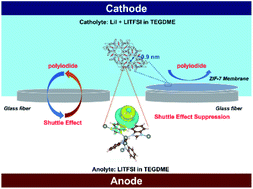A metal–organic framework-modified separator enables long cycling lithium-ion capacitors with asymmetric electrolyte design†
Abstract
The introduction of redox mediators, for example lithium iodide (LiI), into the catholyte of lithium-ion capacitors (LICs) could provide extra capacity through the iodide-involved redox reactions, allowing an alternative strategy to balance the huge capacity gap between the cathode and anode. Nevertheless, the formidable shuttle effect of the soluble mediators results in deteriorated cycling life. Herein, a metal–organic framework (MOF) interlayer is introduced to prohibit shuttling via physical obstruction and mild chemical attraction. After loading the MOF particles on the separator, the micropore of the MOFs could restrict the intragranular diffusion of the redox mediators while their intergranular migration could be prohibited by the mild chemical adsorption exerted by the MOF particles. The electrochemical evaluation reveals that the employment of the MOF-modified separator could boost the coulombic efficiency and cycling life of the activated carbon (AC) cathode with the LiI-included catholyte. Based on this discovery, a LIC was constructed by pairing the AC cathode with the LiI-involved catholyte and nanostructured Li2TiSiO5 anode at the same mass loading where the MOF-modified separator is employed to prohibit the shuttle of iodine species. Because of the synergistic effects, such a LIC could offer a high energy, large power density, and long cycling life.

- This article is part of the themed collection: Journal of Materials Chemistry A Emerging Investigators


 Please wait while we load your content...
Please wait while we load your content...